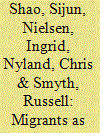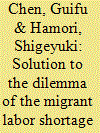| Srl | Item |
| 1 |
ID:
076886


|
|
|
|
|
| Publication |
2007.
|
| Summary/Abstract |
The problem of a shortage of migrant labor is a new development in China's coastal provinces. We discuss the reasons for this emerging phenomenon using a conceptual framework that extends the traditional Lewis dualistic labor market model to incorporate a migrant labor market. We emphasize that migrant labor shortage in China not only reflects a declining wage gap between what peasants receive and what migrants can earn in the cities, but also the institutional legacies of the planning era such as the hukou (household registration) system which discriminates against migrants vis-a-vis urban residents in terms of access to social insurance and other social services. We proceed to draw on a unique survey of migrants and urban residents collected in Jiangsu to show that migrants receive lower incomes, and they have poorer access to social insurance than those with an urban registration in China's cities. Our findings have important implications for the alleviation of the migrant labor shortage problem
|
|
|
|
|
|
|
|
|
|
|
|
|
|
|
|
| 2 |
ID:
090109


|
|
|
|
|
| Publication |
2009.
|
| Summary/Abstract |
Since 2003, China's labor market has been facing two coexisting crises: a rural labor surplus and a severe shortage of migrant labor. Using data from the 2000 China Health and Nutrition Survey questionnaire, which covers 288 villages in 36 counties, this paper attempts to find a solution to this dilemma. Specifically, a multinomial logit model, a Mincer-type model and a probit model are applied to examine the effect of educational level on the employment choices for rural laborers, and on the wages and the employment status of migrants. Based on the results of our analysis, we propose the implementation of policy aimed at increasing the educational level of rural dwellers, in conjunction with other policies to eliminate all artificial barriers, to facilitate the migration of rural laborers.
|
|
|
|
|
|
|
|
|
|
|
|
|
|
|
|